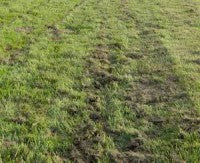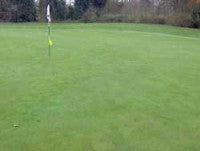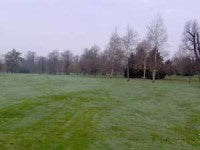Amazing grass at John O'Gaunt
Amazing grass at John O'Gaunt
By Colin Robinson

It never ceases to amaze me how much grass we have to mow here at the John O'Gaunt course. This winter, in particular, the grass has not stopped growing; the combination of a wet July and August last year and the fact that air and soil temperatures did not drop very low during the winter months meant that moisture levels and soil temperatures soon rose quickly in the spring, initiating early season growth.
Our soil is predominantly a sandy loam and with the right moisture content and rainfall tends to promotes vigorous grass growth during favourable conditions. We always get a flush of growth in spring, however, this year, it began weeks earlier.
The greens, tees and aprons have been fine. We always box off the clippings and we are able to control fertiliser inputs. Our problem has been the fairways, rough and semi roughs where we allow the clippings to fly. Under normal circumstances they act as a feed for the grass but, in large quantities, they tend to interfere with mowing quality.

This not only affects the course presentation but also slows down mowing operations, and can often leading to machinery breakdowns because of the additional strain put on them.
Our worst fairways are the 5th, 6th , 11th and 12th with over 13mm of growth per day. They are situated on the old floodplain that runs through the course. Each winter our stream can flood these fairways which, in turn, effectively keeps them damp and fertile.
We are now gradually getting on top of the mowing.
During the winter we tend to keep the greens at 5mm and then begin reducing to our summer playing height of 3.5mm by mid May. We are now cutting daily, except when we apply top dressing materials.
We hollow cored the greens in March and applied about 2.5 tonnes of screened 70/30 sand soil top dressing. This helps restore levels and provide good drainage characteristics at the playing surface.
Our top dressing programme usually consists of four dressings - the first in March, with the remainder following in 5-6 week cycles, aerating with micro tines and applying about half-three quarters of a tonne of topdressing per green.
As our greens are predominantly meadow grass we have to cut to 3.5mm to get decent speeds. Fescue/bent greens, being very fine leaved, will give faster greens when maintained at 4-5mm. I know there are many Greenkeepers in Denmark who are now shaving of their old Poa swards and oversowing with 100% fescue seed mixes so that that can manage their greens at 5mm and achieve better putting surfaces.
To help me achieve fast greens for our competitions I usually bring the cut down to 3mm and undertake some additional rolling. Doing this I can achieve an additional 6-9 inches on the stimpmeter readings. However, we can only keep the greens maintained at 3mm for short periods of time.

We applied our first application of granular (straight ) fertilisers 12:0:9 to the greens in early March. This will last, hopefully, until the end of May when I will be apply a slow release fertiliser, a 14:3:7 didin product with Mg and Iron, which should last about three months.
Our fairways are maintained at 16mm all year round, except during drought conditions. We do not have fairway irrigation, so we raise the cut to 20mm, and particularly on the Carthagena Course where the soils are more sandy.
Some of the fairways have suffered an invasion of speedwell, so these have been target sprayed. sprayed with spearhead.
We purchased some new rough/semi rough mowers this year, changing to Ransome Jacobsen rotary decks. During the main growing season of May to August they are kept busy mowing both the rough (75mm) and we cylinder mow using our old fairway mowers semi rough (30mm) areas twice a week.
We are now back on our grass tees; these are mown 2-3 times a week at a height of 12mm. By mid May they will be down to our summer height of 10mm.
We could possibly go lower, but maintaining at 10mm helps reduce wear. There's a saying in our industry that for every 1mm of grass remaining, the wear characteristic of the sward is increased. I have found this to be quite true.
Nearly all of our greens are pushed up soil greens, built many years ago and designed on a saucer shape principle to retain water. To rectify local wet spots, we initiated a programme of installing localised drainage schemes on the greens. Work to a few more greens was completed this year, so there will be improved playing qualities during wet conditions.
The combination of the mild weather and rain may have kept us busy cutting grass but, as they say, every cloud has a silver lining. Apart from washing in some fertiliser, we have not had to use the irrigation system once this year. That should give quite a saving on our water bill!
